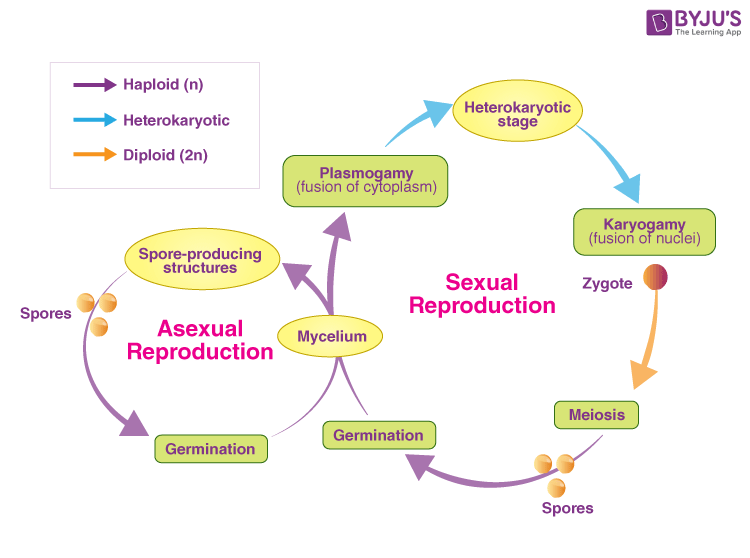Table of Contents
Introduction
Fungi are organisms belonging to the kingdom Fungi that includes 144,000 species of organisms such as yeasts, rusts, mildews, mushrooms and so on. Fungi are the most widely distributed organism on the globe as it has medicinal properties. Fungi are found free-living in the soil or water. Some of these organisms create parasitic or symbiotic relationships with plants and animals. Fungi have been of great importance to human beings, as it produces food items like bread, cheese and wine. Fungi are found everywhere from the air, soil, river, lakes and seas to plants, animals, clothing, etc.
Let’s look at the life cycle of fungi to get a better understanding.
Life Cycle of Fungi

The life cycle of fungi has many different patterns based on the species of the fungi. Not all fungi reproduce in the same way. While some fungi reproduce sexually, others reproduce asexually. Therefore, we are going to look at the life cycle of fungi in the asexual and sexual stages.
Sexual Reproduction of Fungi –
- Spore (Haploid): All fungi begin their life cycle in this stage. This is the first stage in the life cycle of a fungus. In the beginning, all spores are haploid which means that they have only a single copy of their entire genetic material. These spores migrate far distances through the air or by grabbing onto other organisms on the way. After locating a favourable living environment, they grow a bunch of root-like structures called mycelium. Nutrients are transferred through mycelium in order for spores to develop.
- Mycelium (Diploid): When the mycelium grows and develops, it might encounter another fungus. If the two fungi are compatible, a haploid cell from each fungal mycelium fuses together to form a new diploid cell. These new fused cells are diploid as they have more than one copy of their genetic information.
- Meiosis: After the fungus has become mycelium, it enters the next process known as meiosis. During meiosis, a single cell splits into two cells and the genetic material from both parents gets mixed up. The produced two daughter cells do not have identical features to their parents and they do not look similar to each other as well.
Asexual Reproduction of Fungi:
During the mycelium stage, the fungi have the choice of reproducing sexually or asexually. The
asexual life cycle in fungi produces mitospores, which are identical to the parent.
These mitospores later grow into a new set of mycelium and the entire life cycle repeats again.
Conclusion
The life cycle of fungi is quite complex in nature as they do not reproduce in one way, but sexually and asexually based on environmental conditions. Due to its distinct nature, a fungus is capable of surviving anywhere and everywhere.
To explore more information on fungi and others, register with BYJU’S Biology.
Frequently Asked Questions on Fungus Life Cycle
What are Fungi?
Fungi are a separate kingdom of living organisms like plants and animals. Fungi have cells with nuclei. Fungi cell walls contain chitin unlike plant cells, which contain cellulose. From their appearance to their characteristics and behaviour, fungi are distinct from all other living organisms.
Name the three kinds of fungi.
Yeast, mould and mushroom are the three kinds of fungi.
Do fungi need light?
Fungi unlike plants are heterotrophic organisms which cannot produce their own food. Therefore, fungi do not require light to produce food.
Why are fungi important?
Fungi act as dominant decomposers as they break complex plant debris like cellulose. Fungi also recycle nutrients in any habitat where they reside.

Comments